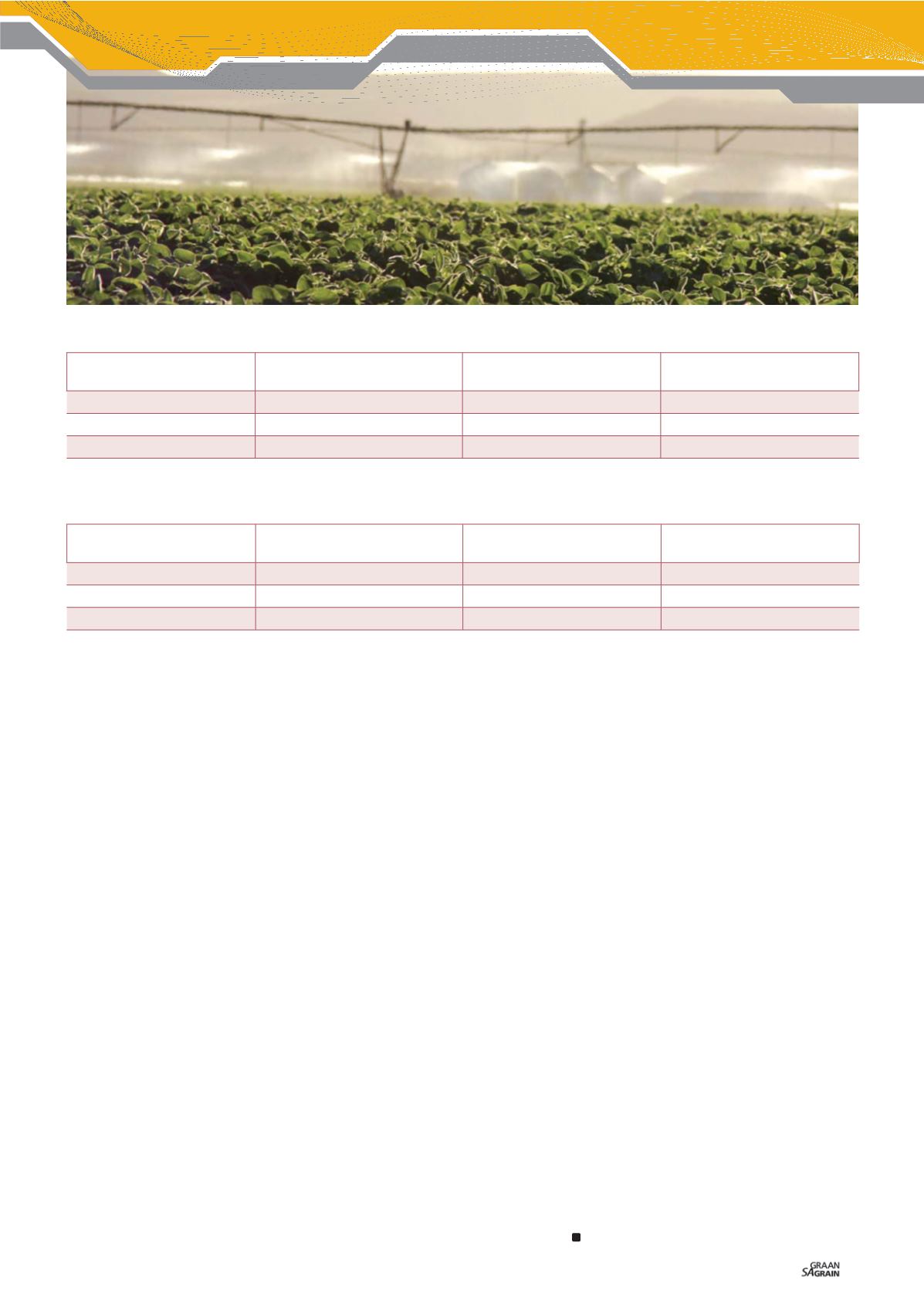

39
October 2017
The saving in electricity cost is the maximum investment cost of
variable rate irrigation technology since that represent the eco-
nomic benefit an irrigator will receive from investing in variable rate
irrigation.
The savings in electricity costs or maximum investment costs were
calculated by comparing an irrigation system without variable rate
irrigation technology with an irrigation system which has variable
rate irrigation technology. The Soil Water Irrigation Planning – En-
ergy (SWIP – E) (Venter, 2015) model was used to calculate electricity
costs by using four different flow rates and pressure requirements
for a system with variable rate irrigation.
The same model was applied to calculate electricity cost for a sys-
tem without variable rate irrigation.
Application
The cost calculation model was applied to calculate the electricity
cost saving (minimum investment cost of variable rate irrigation)
for variable rate irrigation technology for a 30,1 ha centre pivot
with four different flow rates and pressure requirements using the
Ruraflex (time-of-use) electricity tariff.
An assumption was made about the percentage flow rate and
pressure requirement that the centre pivot operates at for each sec-
tion of the field.
Table 1
and
Table 2
illustrate the flow rate, pres-
sure requirement, kilowatt usage, pumping hours, variable, fixed and
total electricity costs for two different combinations of the percent-
age operating time at each section of the field.
Table 3
and
Table 4
illustrate the electricity costs for a system
with and without variable rate irrigation technology for two differ-
ent combinations of operating times at each section of the field,
respectively.
A system with higher operating times at lower flow rates resul-
ted in electricity cost saving of R746 for the 30,1 ha centre pivot
(Table 3). The electricity cost saving is not significant for variable rate
irrigation technology since the maximum investment cost of varia-
ble rate irrigation technology is lower than the actual investment
cost of variable rate irrigation technology (Lee, undated), however,
variable rate irrigation technology has other significant benefits.
The system with the higher operating time at higher flow rates did
not result in any electricity cost savings (Table 4). Thus, investing in
higher flow rates is more economically beneficial than variable rate
irrigation technology. Higher flow rates apply more water, which lead
to lower irrigation hours and thus lower electricity costs.
However, higher flow rates have higher kilowatt usage, but the de-
crease in irrigation hours is more significant than the increase in
kilowatt usage which results in lower electricity costs. Thus, the in-
teraction between irrigation hours and kilowatt usage has a signifi-
cant effect on electricity costs and the maximum investment costs of
variable rate irrigation technology.
Different factors will influence the economic benefit of variable rate
irrigation which include the design of the system, the operating
times at each section of the field, different soil types, management
and electricity tariffs.
Variable rate irrigation has a lot of benefits for the irrigator, but it
is important that each system is analysed individually to determine
the economic benefit of variable rate irrigation technology.
Future research
In the future further research will be done to calculate the economic
benefit of variable rate irrigation for different irrigation systems as
well as to include other factors that influence the economic benefit
of variable rate irrigation in the cost calculation model.
For more information, contact Marcill Venter at
VenterM5@ufs.ac.zaor 051 401 3450.
VARIABLE ELECTRICITY
COSTS (R)
FIXED ELECTRICITY COSTS (R) TOTAL ELECTRICITY COSTS (R)
With variable rate irrigation
27 054
14 038
41 092
Without variable rate irrigation
27 800
14 038
41 838
Electricity cost saving
746
0
746
TABLE 3: ELECTRICITY COSTS AND ELECTRICITY COST SAVINGS FOR A SYSTEM WITH AND WITHOUT
VARIABLE RATE IRRIGATION TECHNOLOGY AT HIGHER OPERATING TIMES AT LOWER FLOW RATES.
VARIABLE ELECTRICITY
COSTS (R)
FIXED ELECTRICITY COSTS (R) TOTAL ELECTRICITY COSTS (R)
With variable rate irrigation
26 648
14 038
40 686
Without variable rate irrigation
26 391
14 038
40 430
Electricity cost saving
-257
0
-257
TABLE 4: ELECTRICITY COSTS AND ELECTRICITY COST SAVINGS FOR A SYSTEM WITH AND WITHOUT
VARIABLE RATE IRRIGATION TECHNOLOGY AT HIGHER OPERATING TIME AT HIGHER FLOW RATES.
Grain SA/Sasol photo competition

















